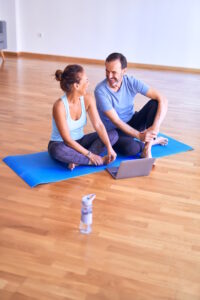
Maintaining strength and balance is essential for seniors to lead active and independent lives. Regular exercise plays a crucial role in achieving and preserving these qualities. Pilates, with its emphasis on core strength, flexibility, and body awareness, offers a safe and effective approach for seniors to improve their strength, balance, and overall well-being. In this article, we will explore how exercise can help seniors improve strength and balance, provide tips for enhancing balance and stability, identify a top balance exercise for seniors, and discuss how Pilates can specifically improve balance.
How can exercise help seniors improve strength and balance?
Regular exercise offers numerous benefits for seniors, particularly in terms of strength and balance improvement. Here are some key ways exercise can help:
1. Muscle strength and endurance: Engaging in strength training exercises helps seniors build and maintain muscle strength and endurance. Strengthening the major muscle groups, including the legs, core, and upper body, contributes to improved balance and stability.
2. Bone health: Weight-bearing exercises, such as walking or resistance training, promote bone health and reduce the risk of osteoporosis and fractures. Strong bones provide a solid foundation for balance and stability.
3. Joint flexibility: Exercises that focus on joint mobility and flexibility, such as stretching or yoga, help seniors maintain range of motion, making movements more fluid and reducing the risk of falls.
How can seniors improve balance and stability?
In addition to regular exercise, seniors can incorporate specific strategies to enhance balance and stability:
1. Balance exercises: Practicing exercises that challenge balance, such as standing on one leg, heel-to-toe walks, or balance board exercises, helps seniors improve their proprioception and strengthen the muscles responsible for maintaining balance.
2. Core strength: A strong core, including the abdominal and back muscles, is vital for stability. Incorporating exercises that target the core, such as Pilates, can improve overall balance and stability.
3. Posture awareness: Maintaining good posture is essential for balance. Seniors should focus on proper alignment and posture during daily activities, such as sitting, standing, and walking.
What is the number one balance exercise for seniors?
While there are several effective balance exercises for seniors, one exercise stands out as particularly beneficial: the single-leg stand. To perform this exercise, stand near a stable surface for support if needed, lift one leg off the ground, and maintain your balance for as long as possible. This exercise targets the leg muscles and challenges balance and stability.
How can Pilates improve balance?
Pilates is an excellent practice for seniors to improve balance due to the following reasons:
1. Core strength: Pilates exercises focus on strengthening the core muscles, including the abdominals, back, and pelvic floor. A strong core provides stability and supports proper alignment, enhancing balance.
2. Body awareness and control: Pilates emphasizes body awareness and precise, controlled movements. This heightened awareness helps seniors maintain balance, adjust their posture, and move with greater control and stability.
3. Flexibility and joint mobility: Pilates incorporates stretches and exercises that promote flexibility and joint mobility. Improved flexibility allows for better balance and reduces the risk of muscle imbalances or falls.
In summary, exercise, particularly Pilates, is a valuable tool for seniors to maintain strength and balance. Through targeted exercises that improve muscle strength, flexibility, core stability, and body awareness, seniors can enhance their overall balance, stability, and confidence in daily activities.